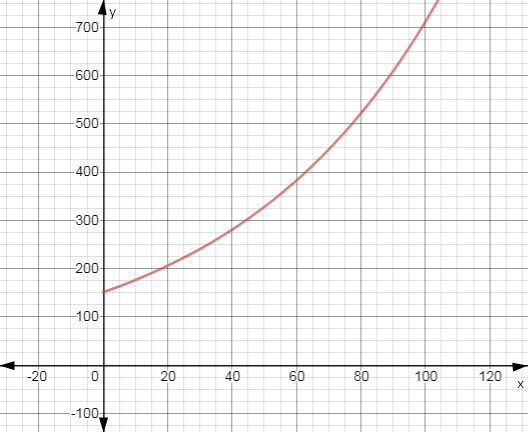
Concept explainers
a .
To find: the value of k and also is the population increasing or decreasing.
a .
Answer to Problem 32E
Population is increasing.
Explanation of Solution
Given:
The population P (in thousands) from 2000 through 2014 can be approximated by the model
Where t represents the year, with
Also in the year 2005, population was 163,075.
Formula used:
The year 2005 corresponds to
The given population model gives the population in thousands Substitute
Take natural logarithms on both sides,
Substituting
The graph of the equation

By looking at the graph it is clear that the population is increasing.
b.
To find: the populations in 2020 and 2025.
b.
Answer to Problem 32E
Population in 2020 is nearly 205,741.
Population in 2025 is nearly 222.320
Explanation of Solution
Given:
The population P (in millions) from 2000 through 2014 can be approximated by the model
Where t represents the year, with
The population in 2020 is found by substituting
Thus, population in 2020 is nearly 205,741.
The population in 2025 is found by substituting
Thus, population in 2025 is nearly 222320.
This answer is reasonable as population as expected is increasing.
c.
To find: the year when the population will reach 200,000
c.
Answer to Problem 32E
2018
Explanation of Solution
Given:
The population P (in millions) from 2000 through 2014 can be approximated by the model
Where t represents the year, with
Formula used:
Calculation:
The given population model gives the population in thousands Substitute
Take natural logarithm on both sides,
Now,
That is, in the year 2018 population will be 200,000.
Chapter 3 Solutions
EBK PRECALCULUS W/LIMITS
- Consider the following system of equations, Ax=b : x+2y+3z - w = 2 2x4z2w = 3 -x+6y+17z7w = 0 -9x-2y+13z7w = -14 a. Find the solution to the system. Write it as a parametric equation. You can use a computer to do the row reduction. b. What is a geometric description of the solution? Explain how you know. c. Write the solution in vector form? d. What is the solution to the homogeneous system, Ax=0?arrow_forward2. Find a matrix A with the following qualities a. A is 3 x 3. b. The matrix A is not lower triangular and is not upper triangular. c. At least one value in each row is not a 1, 2,-1, -2, or 0 d. A is invertible.arrow_forwardFind the exact area inside r=2sin(2\theta ) and outside r=\sqrt(3)arrow_forward
- A 20 foot ladder rests on level ground; its head (top) is against a vertical wall. The bottom of the ladder begins by being 12 feet from the wall but begins moving away at the rate of 0.1 feet per second. At what rate is the top of the ladder slipping down the wall? You may use a calculator.arrow_forwardExplain the focus and reasons for establishment of 12.4.1(root test) and 12.4.2(ratio test)arrow_forwarduse Integration by Parts to derive 12.6.1arrow_forward
- Explain the relationship between 12.3.6, (case A of 12.3.6) and 12.3.7arrow_forwardExplain the key points and reasons for the establishment of 12.3.2(integral Test)arrow_forwardUse 12.4.2 to determine whether the infinite series on the right side of equation 12.6.5, 12.6.6 and 12.6.7 converges for every real number x.arrow_forward
 Calculus: Early TranscendentalsCalculusISBN:9781285741550Author:James StewartPublisher:Cengage Learning
Calculus: Early TranscendentalsCalculusISBN:9781285741550Author:James StewartPublisher:Cengage Learning Thomas' Calculus (14th Edition)CalculusISBN:9780134438986Author:Joel R. Hass, Christopher E. Heil, Maurice D. WeirPublisher:PEARSON
Thomas' Calculus (14th Edition)CalculusISBN:9780134438986Author:Joel R. Hass, Christopher E. Heil, Maurice D. WeirPublisher:PEARSON Calculus: Early Transcendentals (3rd Edition)CalculusISBN:9780134763644Author:William L. Briggs, Lyle Cochran, Bernard Gillett, Eric SchulzPublisher:PEARSON
Calculus: Early Transcendentals (3rd Edition)CalculusISBN:9780134763644Author:William L. Briggs, Lyle Cochran, Bernard Gillett, Eric SchulzPublisher:PEARSON Calculus: Early TranscendentalsCalculusISBN:9781319050740Author:Jon Rogawski, Colin Adams, Robert FranzosaPublisher:W. H. Freeman
Calculus: Early TranscendentalsCalculusISBN:9781319050740Author:Jon Rogawski, Colin Adams, Robert FranzosaPublisher:W. H. Freeman
 Calculus: Early Transcendental FunctionsCalculusISBN:9781337552516Author:Ron Larson, Bruce H. EdwardsPublisher:Cengage Learning
Calculus: Early Transcendental FunctionsCalculusISBN:9781337552516Author:Ron Larson, Bruce H. EdwardsPublisher:Cengage Learning





